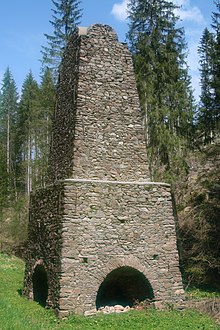Raft oven

A raft furnace is an early form of the blast furnace in which continuous smelting was already possible with the continuous addition of ore and fuel.
description
In the previously used racing and further developed piece furnaces (operated with bellows), a new lining and blowing of the furnace was necessary after each melting. Raft ovens, on the other hand, could be loaded continuously and were therefore more productive. However, due to the higher temperatures, carbon-rich and therefore hardly malleable pig iron was produced , which had to be laboriously refined and slag removed after solidification .
Locations

Guttaring (1578), the blast furnace Hirt and Krems in Carinthia (1541) are named as three of the oldest locations in Austria . On a private property in Edlach in Reichenau an der Rax there is also a listed raft oven.
literature
- Gerhard Sperl: The raft furnace Jan Breuhels the Elder, around 1602. In: Berg- und Hüttenmännische monthly books. - Vienna, 1998. - Vol. 143 (1998), no. 5, pp. 202-203
- Hans Jörg Köster: The transition from the stucco furnace to the raft furnace from a metallurgical point of view. in: Ferrum. Schaffhausen, 1986. - No. 57 (1986), pp. 28-31
- Alfred Hofer: Float furnace and the private hammer mill in Edlach, Reichenau lordship in Lower Austria. In: Res montanarum. - Leoben, 2008. - H. 45 (2008), pp. 95-98